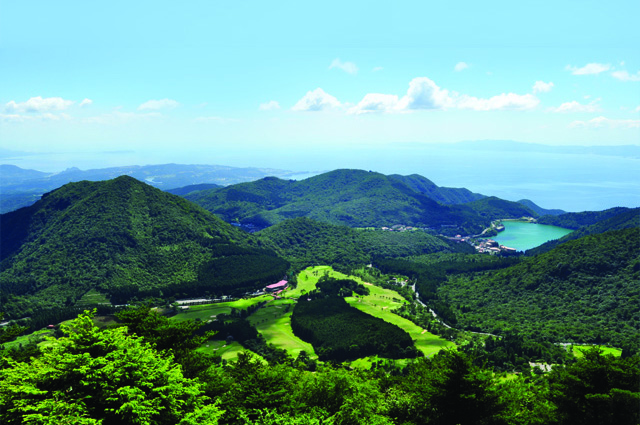Our latest trip to Nagasaki Prefecture took us to Shimabara Peninsula, home of Japan’s oldest national park.
With hot spring resorts both in the mountains and by the sea, dolphin watching hot spots, ancient castles, reminders that this was the first area in Japan to welcome foreign tourists, cable cars with volcanic views and Japan’s first golf course adding up to just a selection of the sights on offer, we had to take a trip to find out more—and made sure we left room for more than just a local lunch.
The whole peninsula is part of the Unzen Volcanic Area Geopark, one of five areas in the country to have become part of the United Nations’ World Geopark Network. In fact this was not only the first area in the country of such geological significance to have been inducted onto that list, it was also Japan’s first National Park, a label bestowed back in 1934.
In essence the Geopark tag means that the area is a kind of living and protected “Earth museum” that can help visitors learn about and understand the natural world around them, but also, of course, it means that there is some pretty spectacular scenery in the region that is unique in the world.
“Obama is a seaside town well-known as a coastal hot spring resort long before the 44th president took his seat in the US – though that hasn’t stopped locals emblazoning onsen towels with a caricatured image of their town’s namesake enjoying a steamy bath”
Geo Saraku is a locally concocted phrase meaning “to walk around the geo-site” and for us this meant hopping in our rental car and choosing one of many sample itineraries recommended by staff at a local tourist information center, who have literature in English that will help you get the most out of your visit, however much time you have. The people around here seem immensely proud of their local area and there is definitely a welcoming feel to many more isolated areas that is pleasing this far from Tokyo.
Our drive first took us in and out of glorious bays to the southeast of Nagasaki City and onwards past numerous fishing villages towards Obama, a seaside town well-known as a coastal hot spring resort long before the 44th president took his seat in the US—though that hasn’t stopped locals emblazoning onsen towels (a novelty souvenir that seemed a snip at ¥200) with a caricatured image of their town’s namesake enjoying a steamy bath.
You’ll know you’ve arrived when you spot that steam spouting from chimneys around a small harbor, and even seeming to flow through guttering at the side of the road. If you are stopping for long, there are plenty of options for lunch here.
Obama Champon noodles seem the most obvious choice (you can’t miss them, but we found our bowl with a view from the second floor overlooking the harbour at Yoshicho well worth writing home about) but you might also head to the seafront market or Marine Park to select and steam or boil your own local vegetables and seafood (including the delicious-all-year-round tairagane crabs) in hot spring water.
Next we headed deeper into the thickly vegetated hills (dolphin watching off the southern tip of the peninsula or checking out its pristine beaches would have to wait for another day) and onwards towards the Unzen City area. We were on the way to one of the first points foreign tourists would have regularly encountered in Japan, and many of the hotels in the cool highland resort offer a nostalgic stay, with the historic Unzen Golf Club that spans the foothills of Mt. Unzen (it opened in 1913) further hinting at that past.
During the Meiji era, foreigners would visit the area from Nagasaki and when a regular ferry connected the city of Shanghai with the region from the 1920s onwards there followed a boom that culminated in the national park’s formation. Strolling through Unzen, past a visitor center that helps you on your way, you’ll find a densely steaming “Jigoku” (hell) geothermal area and some well-signposted hikes.
We climbed onwards up local roads towards the Nita Pass, a stunning road that winds up and around the volcano, looks down on the golf course and lakes below before opening up to offer a view out towards the Ariake Sea. There are many stopping off and viewing points where you can look at evidence of eruptions that have shaped the area over the years, including the Heisei Shinzan, a spectacular lava dome formed in the early 1990s. The Unzen Ropeway will take you further before you wind your way back down the island, but don’t miss the view from the 1,142m Nita Pass Daini Observatory, from which you can clearly see the effects of a catastrophic 1792 collapse that left sheer cliffs and a landscape that appears to have melted and spread out into the sea below.
There is so much to see and do in the National Park and the peninsula as a whole that you could, one feels, spend at least a week exploring the region, but even as a one- or two-day trip that forms part of your exploration of Kyushu, and in particular in Nagasaki, one of Japan’s most diverse prefectures, this might form the highlight of your stay.
Accessing Shimabara Peninsula
The best way to get around Shimabara Peninsula is to hire a car. You can take the ferry from Kumamoto across the Ariake Sea or drive down from Nagasaki Airport, with the journey to Shimabara City taking between an hour and two hours depending on your destination. Local busses and trains do serve the area, though having your own set of wheels will certainly be beneficial.
You can read more about the Geopark and see other sample itineraries at
www.unzen-geopark.jp
Updated On December 26, 2022









